ASUS K53E: Testing Dual-Core Sandy Bridge
by Jarred Walton on April 8, 2011 1:00 AM EST- Posted in
- Laptops
- Intel
- Sandy Bridge
- Asus
The LCD: A Poor Showing Even Among Budget Panels
Once again, we have the usual caveat: the LCD. Even when we’re looking at budget laptops with low-end LCDs, this panel doesn’t impress. The contrast isn’t the worst we’ve seen, but color quality is right near the bottom. I also noticed a dithering pattern when viewing movies and images, more so than with other laptops. I never saw the Gateway ID49C in person, but I’d wager the AUO B156XW02 v6 panel used here gives it a run for the money in terms of being the least desirable LCD. As usual, you get what you pay for, and in this instance you’re paying for a laptop with the least expensive LCD ASUS could scrounge up.
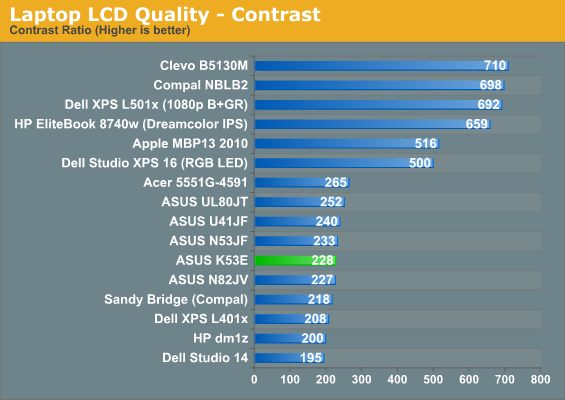
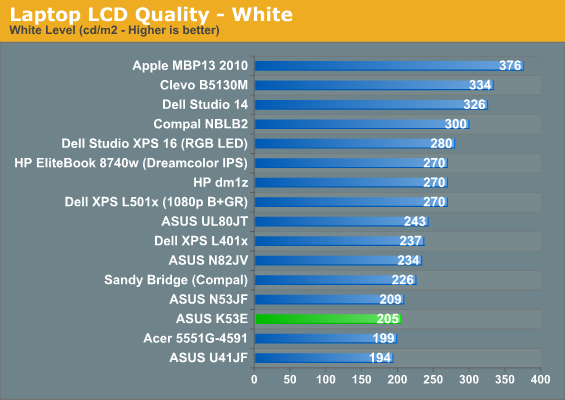

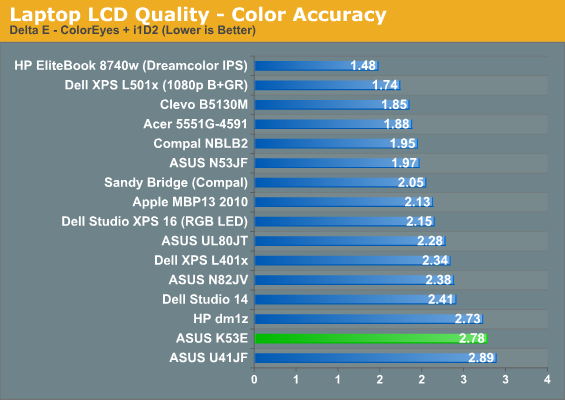
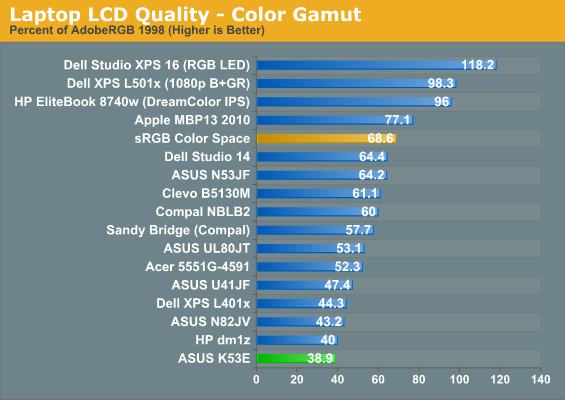
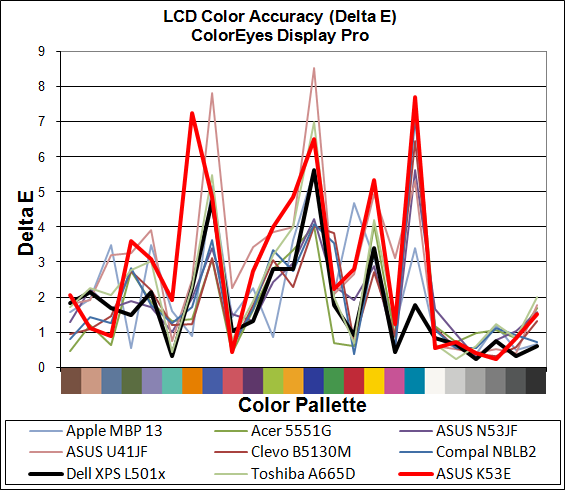

Heat and Noise Levels

For noise and temperature results, we ran through our battery of general application benchmarks (including looping 3DMark06 for several hours). Everything checks out at idle, and load temperatures are within spec. 3DMark06 generates lower CPU temperatures than heavily threaded applications, most likely because the HD 3000 GPU core runs at a higher clock while the CPU runs at stock (or at least not boosted as high). Maximum internal CPU temperatures topped out at 76C, which is lower than we’ve seen with previous laptops, but that might simply be Sandy Bridge vs. Arrandale. External temperatures were also acceptable, but since my digital thermometer is out of commission I don’t have exact figures.
With the reasonable temperatures, noise levels are lower than many competing laptops. At idle, the system is barely above the 30dB noise floor, measuring 30.9dB at a distance of 15 inches. Interestingly, maximum noise levels are a consistent 36.8-37.1dB at load, whether you’re looping 3DMark06 (i.e. playing games), running a 100% CPU load with Cinebench SMP, or doing both. In normal use, though, the laptop remains fairly quiet and wouldn’t cause any dirty looks if used in a business meeting or library.
















78 Comments
View All Comments
DanNeely - Monday, April 11, 2011 - link
Llano's IGP have the potential to be moderately faster than the current entry level mobile IGPs. On paper it's the equivalent to a 6630-6730M. Having to share the DDR3 memory with the CPU will probably hold it back somewhat, but it very much has the potential to a viable part for light gaming systems.mino - Tuesday, April 12, 2011 - link
"to be moderately faster than the current entry level mobile IGPs"Is that a joke or what ?
Llano has the potential to challenge the mid-range mobile GPU market with even its cheapest version running circles around any other IGP/APU around.
kevlno3 - Saturday, July 30, 2011 - link
Pls dont comments when you not read review. Mino , i 100% support you. Llano is the IGP is same speed as HD5650 ,HD6550 or even HD6630. it's not HD5470 or even HD3000 can be compare.it's totally complete solution for value of money best buy. but Intel keep creat the high benchmark score to blur the consumer . try to make people feel regret if you pay such money to buy the low end Llano. in fact , i was totally disappointed with Intel. Core i3 2310 can't perform well. i even felt lag when i play in war craft 3 frozen throne in battlenet during 3 vs 3. i can't find my pointer. it's normally lag will make u have this problem.
biostud - Friday, April 8, 2011 - link
both s and b models :)jonup - Friday, April 8, 2011 - link
Just from curiosity, does dropping from dual channel to single channel have any significant effect on the performance of the modern laptops/desktops? Many manufactures have been shipping their laptops with odd RAM capacities 3GB/6GB, which has been a turnoff for me, but it appears to be a good marketing gimmick for those who have no clue.Thank for the nice laptop reviews you guys put out there!
IntelUser2000 - Friday, April 8, 2011 - link
The manufacturers I think bundle the smaller capacity DIMM for free so sell that and get a matching stick from NCIX or something.The way the asynchronous dual channel(Intel Flex Memory) works is only half of the greater capacity DIMM is transferring data simultaneously with the smaller DIMM.
So:
4GB + 2GB
4GB stick: 2GB Dual channel + 2GB Single channel
2GB stick: This is doubled up with half of the 4GB stick
So in theory your max bandwidth is like 1.5 channels. Measured bandwidth is between single and dual channel too, but the complexity of splitting the greater capacity puts performance closer to a single channel in some applications.
mino - Tuesday, April 12, 2011 - link
It does not work that way. In any mixed config the IMC falls back to a single-channel-like operating mode.JarredWalton - Tuesday, April 12, 2011 - link
It would be nice if you at least tried to do some research before making completely false statements. Flex memory works exactly as IU2k describes, with basic details here:http://www.intel.com/support/motherboards/desktop/...
Pretty much every Intel CPU/chipset since the P45/X38 has supported flex memory. All you have to do is check ARK:
http://ark.intel.com/Product.aspx?id=52229&cod...
Quote: "Intel Flex Memory Technology -- Facilitates easier upgrades by allowing different memory sizes to be populated and remain in dual-channel mode." Don't confuse limitations of older chipsets and AMD's (older) IMC with current implementations.
silverblue - Friday, April 8, 2011 - link
...that Brazos isn't clocked higher nor operates on a dual channel memory bus. It would be amusing to expect a 500MHz GPU sporting a bandwidth limitation with a mobile part which is 650MHz and, with Turbo, 1.3GHz, and utilises a dual-channel bus, and that's well before we factor CPU performance into things.For what it does, Brazos is excellent, but people really shouldn't think of it as competition for Sandy Bridge. It's really not meant to be anywhere near close to it in terms of performance or price, and it's a shame that some manufacturers seem to have forgotten that. Unfortunately, as said before, Brazos machines may encroach on CULV territory...
IntelUser2000 - Friday, April 8, 2011 - link
An error and few points I'd like to make:"Even the U41JF can’t match the K53E for efficiency, despite underclocking the i3-380M to 700-900MHz (instead of the normal 933-1200MHz) and having a smaller 14” LCD."
i3-380M is a 2.53GHz part. Why are you testing an underclocked version on the battery life test again?
"What really impresses me is that you can get similar battery life (in light workloads) with either the dual-core or quad-core SND parts,"
Huh. Equalizing to battery capacity:
DC(QC) min/WHr
Idle: 7.66(6.63) +15.5%
Internet: 6.43(5.86) +9.7%
H.264 playback: 4.77(3.66) +30.3%
10-15% increase in battery life is not identical. Also, the screen on the QC system is larger, but sports a more efficient SSD drive. If the Hurry up and Get Idle works well, it would be better on the QC thanks to the SSD.
"Ah, but the E-350 has a much better IGP, right?"
I'm not sure whether that's a question or a statement. While the E-350 has a HD5450/5470 core, its severely bottlenecked by memory subsystem, in addition to having it share with the GPU, before the CPU differences.
"The result is better battery life, but compared to Arrandale it’s not a huge change in two of our tests."
SNB DC(ARND)
Idle: 7.66(6.64) +15.3%
Internet: 6.43(5.29) +21.6%
H.264 playback: 4.77(3.07) +55.3%
While Idle and Internet battery life isn't big as H.264, 15-20% battery isn't something minor. In fact, if you look back to Core 2 vs Core Duo and Penryn vs Merom comparisons, the battery gains are equal to 2x for the ones back then.
Overall I think the DC Sandy Bridge is being underrated on the review. The asynchronous RAM is a bit of a sore to look at too. Last benchmark I put the bandwidth figure at somewhere between single and dual channel, and Intel documents indicate increased latency when transferring between sticks.